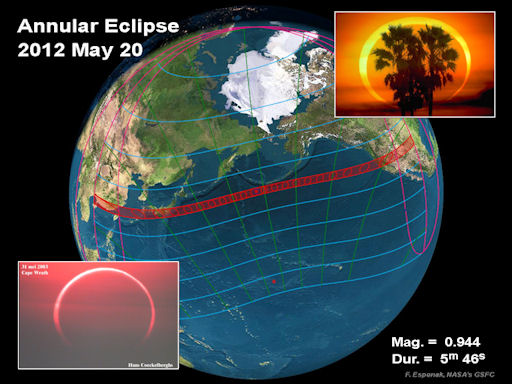SUBSIDING STORM: A radiation storm around Earth is subsiding. The storm began during the early hours of May 17th when a strong M5-class flre accelerated a fusillade of solar protons in our direction. At its peak, the S2-class storm was capable of confusing spacecraft imaging systems and causing 'single event upsets' in orbiting electronics. Radiation storm alerts: text, phone.
SOLAR ECLIPSE THIS WEEKEND: On Sunday, May 20th, the Moon will pass in front of the Sun, producing an annular solar eclipse visible across the Pacific side of Earth. The path of annularity, where the sun will appear to be a "ring of fire" stretches from China and Japan to the middle of North America:
An animated eclipse map prepared by Larry Koehn of ShadowandSubstance.com shows the best times to look. In the United States, the eclipse begins at 5:30 pm PDT and last for two hours. Maximum coverage is around 6:30 pm PDT.
Because this is not a total eclipse, some portion of the sun will always be exposed. To prevent eye damage, use eclipse glasses, a safely-filtered telescope, or a solar projector to observe the eclipse. You can make a handy solar projector by criss-crossing your fingers waffle-style. Rays of light beaming through the gaps will have the same shape as the eclipsed sun. Or look on the ground beneath leafy trees for crescent-shaped sunbeams and rings of light.

![]()
Solar wind
speed: 372.0 km/sec
density: 3.5 protons/cm3
explanation | more data
Updated: Today at 1646 UT
![]()
X-ray Solar Flares
6-hr max: C1 1154 UT May17
24-hr: M5 0147 UT May17
explanation | more data
Updated: Today at: 1600 UT
![]()
![]()
![]()
Daily Sun: 17 May 12
![]()
![]()
Previously active sunspot AR1476 continues to decay. Solar activity is low. Credit: SDO/HMI
![]()
![]()
![]()
Sunspot number: 122
What is the sunspot number?
Updated 15 May 2012
Spotless Days
Current Stretch: 0 days
2012 total: 0 days (0%)
2011 total: 2 days (<1%)
2010 total: 51 days (14%)
2009 total: 260 days (71%)
Since 2004: 821 days
Typical Solar Min: 486 days
Updated 15 May 2012
The Radio Sun
10.7 cm flux: 129 sfu
explanation | more data
Updated 15 May 2012
![]()
![]()
![]()
Current Auroral Oval:
![]()
Switch to: Europe, USA, New Zealand, Antarctica
Credit: NOAA/POES
![]()
![]()
![]()
Planetary K-index
Now: Kp= 1 quiet
24-hr max: Kp= 4 unsettled
explanation | more data
![]()
Interplanetary Mag. Field
Btotal: 12.0 nT
Bz: 9.2 nT north
explanation | more data
Updated: Today at 1647 UT
![]()
![]()
![]()
Coronal Holes: 16 May 12
![]()
![]()
There are no large coronal holes on the Earthside of the sun. Credit: SDO/AIA.





